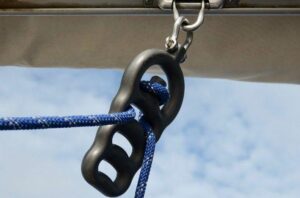In 2022, the SNSM coast guards were called out 4742 times, with 1904 of these for search and rescue operations. Out of the 9756 people saved at sea, more than 66% were out on pleasure boats.
119 people have been reported dead or missing as part of the SNSM’s operations (according to the 2022 annual SNSM report).It’s easy to take safety precautions every time you’re preparing to take your boat out and help prevent risks relating to accidents on board (booms, motor, electric and other), injuries or falls. installing the life line correctly.
1. What is a life line ?
A life line is a piece of safety equipment at each end of the deck of a boat, running from the front to the back and allowing you to move more safely across the deck. These used to be cables, but have recently been replaced by flat strap-type models.
2. How do you install your life line ?
To install your life line as securely and eectively as possible, it must be installed as close as possible to the median line of your boat. The line must be taut so it doesn't move in the wind or give too much slack in the event of a fall. It must however be possible to easily attach snap hooks so that they can run easily along the line and not hinder movement on the deck. Ideally, you should install it on top of the deckhouse, at each side so it runs to a single point in the middle of the front. As far as possible, you should move around on deck within the limits of the shrouds.
Important: don’t forget to run the life line over the ropes and mooring equipment.
Tip: To prevent a life line from snapping at the deck because of wind, give it one or two twists. It is important to attach your life line to properly adapted mooring points, and in particular these must meet the standard ISO 15085. At Wichard, our jointed chainplates (ref 6604, 6605 and 6606) comply with this standard and enable you to attach your life line. Ideally, the jointed chainplate should be mounted using a counter-panel and bolts.
3. The Lyf’Safe kit from Wichard
A few years ago, Wichard released the Lyf’Safe Kit, a life line kit that is both ready to use and easy to install. The fully adjustable Lyf’Safe Kit will adapt to the length of your boat’s deck using the forged loop provided with the kit.
Perfectly suited to night-time navigation thanks to the reflective strip and the photo-luminescenthousing, these life lines are easy to identify during nocturnal manoeuvres.
4. Maintaining your life line
You must check your product every 6 months. You may need to check it more frequently, according to the type and frequency of use. Regularly check the straps and the seams on the loop. Monitor the appearance of cuts, wear, and damage resulting from product use, from heat, from the use of chemical products, etc.
In any case, the Lyf’Safe Kit must not be reused once damaged or torn, even if only partially. If you have any doubts, have it checked by a qualified professional.
In order to extend the life span of your Lyf’Safe Kit, we recommend rinsing the strap, the loop and the housing in fresh water after each use. If you are wintering your boat for an extended period, we also recommend disassembling the kit. Store this in a dry and well-ventilated place, away from direct sunlight, extreme temperatures, and corrosive or aggressive materials.

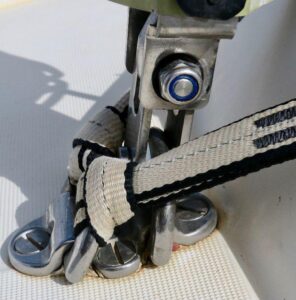
Choosing the right tether
1. What is a tether ?
This is a link between you and your boat. The tether connects you to your boat’s life line. For high-seas navigation, more than 6 miles from port, you must have 1 harness and 1 tether per person on board a sail boat.
2. Choosing your tether
You can choose the tether model according to the age of the person who will be using it:
we recommend that children be equipped with a tether model that has just one snap hook and loop. The loop is attached to the life jacket. The loop must be attached on the part of the life jacket that will prevent the child from detaching themselves.In any case, it is important to choose a tether that complies with the ISO -2009 standard.
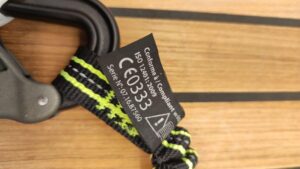
Find all our tips about choosing your tether in our article dedicated to the subject.
3. Caring for your tethers
Tethers must be checked as frequently as possible, especially before each sailing season and before each sea outing. It is important to check that the snap hooks are working correctly, and to check that the webbing has no tears or loose seams. If there is any doubt, we recommend taking your product to a specialist retailer.
In terms of maintenance, we recommend rinsing your tethers in soapy water after each use, and drying them out in a well-ventilated area. When it comes time to winter them, rinse your tethers and dry them in a well-ventilated area before storing them away from light or chemical products which could aect their life span.
4. Wichard tethers
Wichard offers a range of dierent tether models, running from 1 to 3 snap hooks for a single tether and with flat or elastic straps. Certain models also come with a quick-release snap hook.
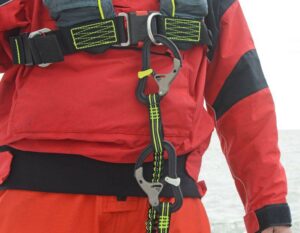
Keep safety knives in strategic locations
At the gantry, by the mast, in the anchor locker or down from the cockpit, there are a number of good places to store your safety knife. On multi-hulled craft, you can also put them on the front beam or in the middle of the harness. These strategic locations will give you quick access to your tool when you need it and act quickly in the event of an emergency.
This knife has been tested by sea rescue professionals and can be vital in the event of an emergency. It is easy to attach, using the 4-loop sheath which can be mounted using a strap or screws. The rear is flat, allowing you to stick it to the wall of the cockpit, for example. For even more safety, you can also attach it to your life jackets.
To care for your safety knife, regularly take it out of the sheath to let it dry and prevent corrosion. The MA5 stainless steel blade offers excellent corrosion resistance and great cutting power, allowing you to slice through even the thickest ropes. Wichard offers a wide range of safety knives and their accessories, which are essential both on land and at sea.
Enjoy safer manoeuvres with a boom brake
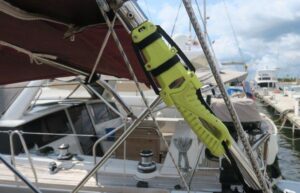
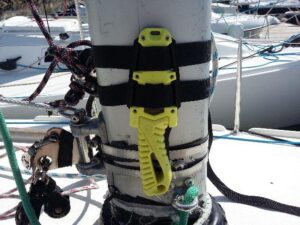
1. What is a boom brake
A boom brake is a piece of safety equipment which allows you to control the movement of the boom during gybing, whether deliberate or accidental in a tail wind. This is extremely useful when sailing o the wind, out at sea.The boom brake is also a great way to secure the boom when the sails are goose-winged, helping stabilise the boom and take the reef or furl the sail, or even simply to immobilise the boom at port or at anchor.
2. The Gyb’Easy boom brake by Wichard
A few years ago, Wichard released the Gyb’Easy boom brake, which uses a rope that can be let out a long way, and that can be run through one or several bilge holes. The boom brakes work using the friction of the rope on the brake. Lightweight and extremely robust with no mechanical parts, it can be easily installed under the boom.

